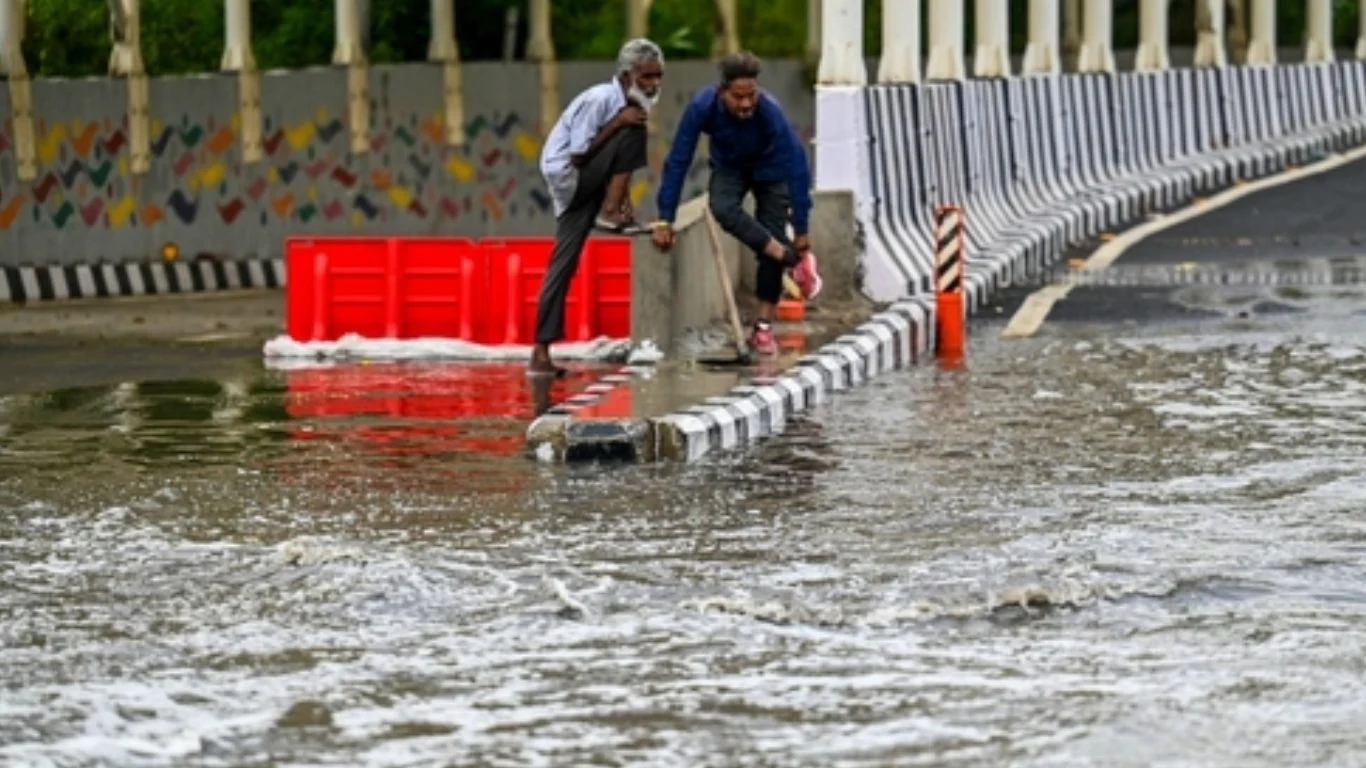
On Friday morning, residents across Delhi-NCR were jolted awake by an intense and unexpected bout of extreme weather. Thunderstorms, strong gusty winds, and heavy downpours swept through the region, resulting in widespread disruption to daily life. The sudden change in atmospheric conditions caused significant waterlogging and paralyzed road and air traffic across the capital and neighboring areas like Gurugram. At Delhi’s Indira Gandhi International Airport, operations were severely impacted, with over 100 flights facing delays. The Delhi International Airport Limited (DIAL) issued an urgent advisory, urging travelers to check their flight statuses directly with airlines to avoid confusion and last-minute changes.
Across Delhi-NCR, the morning brought chaos. The downpour triggered flooding in numerous low-lying neighborhoods, sparking traffic bottlenecks and gridlock. Commuters attempting to navigate their way through the city faced a frustrating experience as many roads became impassable due to water accumulation and fallen trees. The capital’s already strained traffic infrastructure struggled to cope with the weather-induced strain, with reports of vehicle breakdowns adding to the commuter woes.
Gurugram, in particular, bore the brunt of the deluge. The city’s roads turned into virtual rivers, leaving office-goers and early commuters stranded. Authorities reported that nearly every part of the city experienced the effects of the downpour, with only a handful of areas escaping waterlogging. Among the worst-hit locations were the service lane near Narsinghpur on the Delhi-Gurugram Expressway, Basai Road, and major residential and commercial sectors including Sector 10, Sector 4, Sector 7, Sector 9, Sector 48, and Sector 57. Additional problem spots included key junctions and chowks such as Jharsa Chowk, Hanuman Chowk, Subhash Chowk, Baghtawar Chowk, Fazilpur Chowk, Vatika Chowk, and Mahavir Chowk. The older parts of the city like Jacobpura, Sadar Bazar, and Dundahera were also badly inundated.
The Delhi-Gurugram Expressway witnessed particularly heavy traffic congestion, with vehicles moving at a snail’s pace due to the waterlogged lanes. Major junctions like Hero Honda Chowk, Rajiv Chowk, and IFFCO Chowk became choke points where traffic stalled for hours. Local police personnel were deployed in large numbers to manage the congestion and assist in diverting traffic away from severely affected zones. At the same time, municipal workers and civic authorities were dispatched across the city to unclog stormwater drains and restore some semblance of normalcy.
Meanwhile, Delhi experienced similar challenges. Several parts of the city, including key routes like Minto Road and areas around the airport, reported heavy waterlogging. The flooding led to uprooted trees, which blocked roads and contributed to vehicle breakdowns and delays. These conditions not only disrupted traffic but also posed risks to pedestrian safety. Visuals of submerged roads, stalled buses, and commuters wading through knee-deep water surfaced across social media, highlighting the extent of the infrastructural strain caused by the downpour.
Delhi Chief Minister Rekha Gupta responded to the situation by visiting flood-prone areas, including Majnu Ka Tila, where she inspected the waterlogging and ongoing civic works. She directed local authorities to begin immediate repair work on potholes and drainage systems to mitigate similar risks during the upcoming monsoon season. Her visit underscored the urgency of strengthening urban resilience in the face of increasingly unpredictable weather events.
In light of the disruption, city authorities and weather officials advised citizens to remain cautious and take preventive measures. For those who must travel during adverse weather, several precautions are recommended to ensure safety:
* **Stay Informed**: Keep track of weather bulletins and traffic updates through reliable sources before leaving home.
* **Plan Ahead**: Factor in potential delays by allocating extra travel time.
* **Drive Carefully**: Maintain reduced speeds and safe distances, especially on slippery or partially flooded roads.
* **Avoid Waterlogged Routes**: Refrain from attempting to drive through flooded underpasses or low-lying roads, as water levels can rise quickly and stall engines.
* **Check Flight Status**: Air travelers should verify their departure and arrival details directly with airlines or the airport before heading out.
The unexpected weather event serves as yet another reminder of the vulnerability of urban infrastructure to extreme climate patterns. While emergency services and civic agencies worked promptly to manage the crisis, the scale of disruption highlights the pressing need for long-term solutions. As the monsoon season approaches, both Delhi and Gurugram will need robust preparedness strategies to prevent recurrence of such chaos.
By staying alert, planning with caution, and supporting public advisories, residents can better manage the inconveniences caused by sudden weather shifts and ensure safer mobility during future storms.













